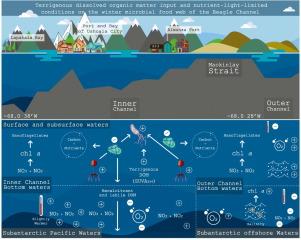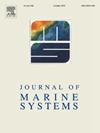Terrigenous dissolved organic matter input and nutrient-light-limited conditions on the winter microbial food web of the Beagle Channel
Abstract
The viral shunt and microbial loop are trophic pathways in the microbial food web, recognized as major drivers of carbon and nutrient cycles in the sea. The Beagle Channel, located at the southernmost extreme of South America, is a subantarctic marine environment influenced by terrestrial runoff and glacial meltwater with high temporal and spatial variability. There is a knowledge gap on the trophic pathways and the microbial food web in the eastern part of the Channel. We herein present for the first time a comprehensive and spatially wide study of the effects of physicochemical and bio-optical parameters on the microbial food web along the Eastern Beagle Channel. The study took place under winter hydrographic conditions, featuring weak vertical stratification of the water column and low chlorophyll a concentrations (0.13 ± 0.07 mg m−3). Biogeochemical gradients were notable between the inner and outer (easternmost) sectors of the Channel, separated by a shallow sill at Mackinlay Strait. As a chemical water mass tracer, the presence of the highest concentrations in bottom waters of NO3 + NO2 in the inner channel and the difference in the T-S diagram indicate the Subantarctic Pacific origin of this water mass. Structural equation models showed that the specific UV absorbance of water (SUVA254, a proxy for the aromatic carbon content) and NO3 + NO2 were the main parameters affecting the microbial food web in surface/subsurface waters suggesting that prokaryotes biomass was partially supported by allochthonous dissolved organic matter (DOM) derived from river discharges. Our results show a major role of the viral shunt in surface/subsurface waters retaining nutrients in the basal levels of the food web. We suggest that the viral shunt in surface/subsurface waters and the water residence time west of Mackinlay Strait allows infected cells and viral lysis products to reach bottom waters propelling the production of recalcitrant and labile DOM there.


 求助内容:
求助内容: 应助结果提醒方式:
应助结果提醒方式:


